JDC Fall-1998 v1 - Bartering for Diversity: The International Reciprocal Distance Education Model
Bartering for Diversity: The International Reciprocal Distance Education Model
Guillermo P. Vasquez de Velasco, Ph.D.
Texas A&M University
E-Mail: vasquez@archone.tamu.edu
Nancy L. Holland, Ph.D.
Texas A&M University
E-Mail: nholland@tamu.edu
Abstract
This article presents a summary of the methods developed at Texas A&M University (TAMU) to introduce an international perspective in the classroom using the Reciprocal Distance Education Model. The methods presented are: Synchronized Reciprocal Design Studio, Asynchronous Reciprocal Design/Construction Studio, Direct Reciprocal Exchange of Lectures, Joint Debate, and Continuing Professional Development/Internship. This discussion is followed by conclusions addressing the advantages for students, faculty, and administrators.
Globalization and Diversity
Promoting diversity has been a major priority of many universities for several years; and, for as many years, obtaining diversity has been a challenge for many schools of design and construction. In the past, the term diversity has been primarily associated with achieving national racial, gender, and cultural equity. With the advent of low cost global communications networks, the potential for small and medium sized companies to enter the global market is a reality. As a result, today, the term diversity must extend beyond national borders to include a global community. Not only is this important from an idealistic perspective, but, it is becoming increasingly evident that students graduating today must be prepared to take their place in an international market.
As teachers, we must offer our students learning opportunities to prepare them for participation in an international market. The learning opportunities we offer must be multilingual, multicultural and quite diverse with respect to professional practices. Ideally, such learning opportunities should be an integral part of the course curriculum. Thus, the need for adding an international dimension to the architecture and construction curricula is imperative. Some conventional models for achieving global diversity in the classroom are presented below as conceptual framework for the description of an innovative model: "The International Reciprocal Distance Education Model."
Conventional Methods to Achieve Diversity
The conventional methods for achieving diversity in the classroom can be broken down into two groups, the national and the international. At the national level the most widely applied model to achieve diversity has been based on the recruitment and retention of minority students and faculty. In the past, this has been primarily directed toward the African American and Hispanic communities. While this effort must be continued, it must be broadened to embrace the world at large.
At the international level, the emphasis has also been two-fold: the importation and exportation of students and faculty. With respect to faculty, the tendency has been to hire international faculty that can bring diverse instructional perspectives and experiences. However, the availability of high level applicants can be limited, immigration procedures are extremely laborious, and the cost of recruiting and retaining international faculty is high. The same may apply in the case of visiting scholars. As an alternative, local faculty are encouraged to teach abroad in an effort to enhance heir ability to bring an international dimension to their courses. Programs that allow faculty to teach abroad are valuable experiences, but require considerable planning since outgoing instructors need to be replaced at their home institution. A growing number of professors have used their sabbatical privileges to join the faculty of foreign institutions of higher education.
With respect to students, an international experience has been achieved through numerous study abroad programs. In the case of study abroad programs, the primary limitations are cost and disruption of the student's progress in completing required courses for graduation. Study abroad programs have been subjected of criticism because of the level of cultural immersion that is offered tends to be minimal. This is due to the fact that in most cases home faculty travel with the study abroad group, the courses continue to be delivered in English, the students continue to interact mostly among themselves, and their contact with the foreign environment is not greater than that of a tourist.
As an alternative to study abroad programs, many universities have instituted reciprocal student exchanges. With this method, students travel to a foreign country and in exchange, foreign students take their place at the home institution. With the reciprocal exchange program, the level of cultural immersion achieved can be very high; however, very few students tend to participate due to language limitations, prior poor academic performance, and/or rigid curriculum requirements. Frequently, American universities must restrict the number of foreign students they can receive in order to maintain parity. As a result, it is common to find programs for reciprocal student exchanges serving a very small number of students at a relative high administrative cost.
Yet another method is international independent studies. In this case the student travels to a foreign country where he/she performs a specific set of learning tasks. This is one of the most powerful and long lasting experiences any student can have but it is certainly costly and it is usually the result of wining a scholarship or award on a competitive basis. Students that participate in international independent studies tend to graduate later since they are unable to continue the required course load during their stay abroad. In some cases international independent studies are organized during the summer months in order to avoid this setback.
In summary, the conventional strategies for adding an international dimension to our curricula tend to be limited because of one or more of the following reasons:
- They imply travel and lodging expenses that are beyond the fixed budget of the average student and/or faculty.
- They imply administrative costs that tend to be high. This may include: immigration requirements to hire international faculty, administrative arrangements for substitute teachers for replacement of instructors on sabbatical, or the administrative costs of maintaining reciprocal exchange programs that serve very few students.
- They are difficult to tailor towards specific levels of cultural immersion on a course by course basis.
- They usually result in delayed graduation for students since they are usually not always able to enroll in the full complement of courses to comply with their degree plans.
Due to these limitations, in 1996 the College of Architecture at TAMU began to experiment with a number of different dynamics that make use of computer technology and telecommunications for adding an international dimension to the curricula. Presently, one can group all such dynamics into one non-conventional model known as “The Reciprocal Distance Education Model”
The Reciprocal Distance Education Model
The purpose of the Reciprocal Distance Education model is to provide a personal international experience for students of participating countries without having to leave their home university. Strategically, in order to implement the model the following requirements were recognized: 1) there must be no additional cost for the participants, 2) administrative cost per capita must be minimal, 3) it must be flexible for the surgical application of an international dimension not only at curricular level but also at syllabus level, and 4) it must be in full compliance with degree plan structures. Equally as important in order to minimize risk, since there was no model to pattern after, was that it must not require additional new equipment or resources.
The new model required the use of existing computer resources, the Internet, and a dedicated T1 line (broadband optic fiber line) that links the College of Architecture of TAMU in College Station, Texas, with the TAMU Center in Mexico City. Thanks to the Trans-Texas Videoconferencing Network (TTVN) of TAMU, that includes more than 100 videoconferencing sites in Texas and Mexico. Over the last two years we have been able to develop a number of methods for implementation. The T1 line to Mexico City, is the only resource not commonly available to most post-secondary educational institutions. However, it will be soon possible to substitute the T1 line with an Internet II connection that will permit very similar performance at a largely reduced cost. The implementation methods described below will be compatible with the technical resources of most North America universities by the year 2000.
The implementation methods described below have been strongly supported by Memoranda of Agreement signed between TAMU and several schools of architecture in Mexico. TAMU maintains conventional student exchange programs with these schools and the Reciprocal Distance Education Model was developed in conjunction with on-going activities. One of the fundamental objectives of the model is to reinforce conventional programs while offering an alternative for students with limited access to such programs.
Methods for Implementation of the Reciprocal Distance Education Model
1. The Synchronized Reciprocal Design Studio consists of two studio professors from different universities using the same design assignment simultaneously. Throughout the semester communications are maintained through student web pages and e-mail on a student-to-student and student-to-professor basis. In addition, four times throughout the semester, the students present their work for formal critique to professors and students through the use of videoconferencing. This was initially implemented during the fall of 1996 between 4th year design students of TAMU and Universidad La Salle (ULSA) of Mexico City. Since then the model has been implemented every fall semester with an increasing level of student popularity and participation. One of the main findings, to date, is the generation of a healthy competitive attitude between both design teams and the amount of additional time the students invest in their design assignments. It has also been noticed that the students tend to enjoy identifying their cultural differences and discussing them at considerable length. For more information on these implementations our readers may wish to review the fall 97 and fall 98 entries of The Tex-Mex Virtual Design Studio. During the fall semester of 1998, this method has been replicated by additional 3 design studios of the College.
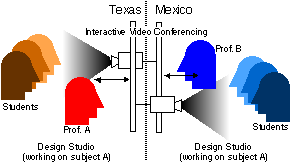
2. The Asynchronous Reciprocal Design/Construction Studio consists of a design studio in the U.S. presenting their work to a panel of four design professors in Mexico. And a construction studio in Mexico presenting their work to a panel of construction professors in the U.S. This method also uses the Internet for continuous communication and periodic videoconferencing for formal critiques. This method was initially implemented during the spring of 1997 between students and professors of TAMU and ULSA. This model was adopted for the spring semesters in order to eliminate scheduling conflicts that made the synchronous design studio impossible to implement. Since then the model has been implemented two times and in both opportunities the results have been very positive. The Asynchronous Reciprocal Design/Construction Studio promotes formal presentation skills and the ability of students to defend their projects and address issues that are taken for granted within their own cultural context. For more information on these implementations our readers may wish to review the spring 97 and spring 98 entries of The Tex-Mex Virtual Design Studio.
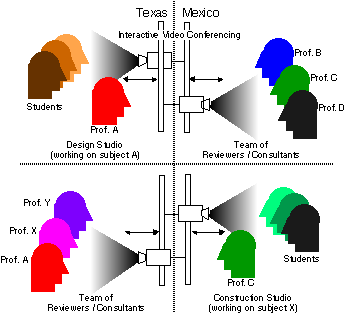
3. The Direct Reciprocal Exchange of Lectures method of implementation relies upon professors or professionals from another country to either teach the whole class or supplement a course with lectures on specific topics. Videoconferencing is the preferred method of communication. This method was initiated in 1997 with a routine series of lectures between TAMU and the Instituto Tecnológico de Estudios Superiores de Monterrey (ITESM). This was followed by the exchange of keynote addresses at the 1998 Southwest regional meeting of the Association of Collegiate Schools of Architecture (ACSA). At this event, a key note speech delivered by a professor of the Universidad Nacional Autónoma de Mexico (UNAM) was bandcasted to 12 different videoconferencing sites in Texas, New Mexico, and Mexico. In reciprocation, a keynote speech delivered by a professor of the University of Texas at Austin (UT Austin) was bandcasted to the same network of interactive sites. The participants were extremely pleased with the high level of interaction achieved during the videoconference. Following this very successful experience, TAMU and UNAM are developing a joint lecture series for the spring of 1999.
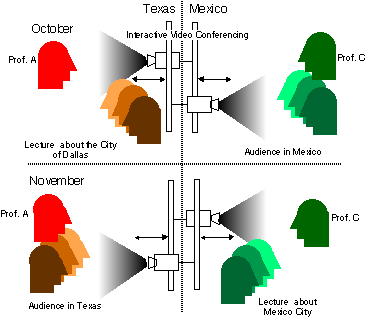
4. The Joint Debatemethod brings together students from two universities to make presentations on specified topics followed by a discussion that highlights the differences between the two countries and the positive and negative aspects of each. Videoconferencing is the preferred method of communication. This method was largely motivated by the need for more time to discuss some of the issues raised in the virtual design studios. The method was successfully implemented during the fall of 1998 between students of TAMU, ULSA, and ITESM. Some of the issues discussed were: What is the social commitment of the Architect? Can we teach Design?, Are Mexican and American students of architecture any different?, and What is the impact of computers on the design product? Initial results have been very positive. The debates have been intense and in each instance the limiting constraint was time rather than lack of comment. Several students have continued to debate the issues using e-mail.
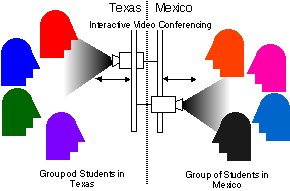
5. The Continuing Professional Development/Internship method provides for professionals and/or professors from participating countries to expand their knowledge in a particular area through the expertise of one of the participants. The internship model allows students of one country to work for a company of another country for a summer. We have been able to make some basic implementations of this model during the summers of 1997 and 1998. In both cases TAMU students have travel to Mexico were ULSA faculty and administrators have facilitated their participation in summer internships. The students report the experience as positive but the lack of financial remuneration while performing the internship in Mexico is a clear limiting factor. In the future a reciprocal exchange of interns is anticipated as a mechanism through which both American and Mexican interns may continue to be remunerated by their own companies while working for a foreign company.
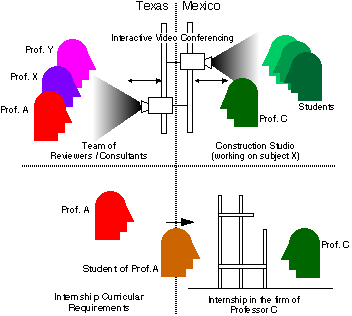
The Bartering Concept
The methods for the implementation of the model depend on complex bartering conditions that fuel faculty participation. As reported in other publications (Vasquez de Velasco & Holland, 1998), tenure track faculty and those seeking promotion gladly participate in the dynamic as exporters of instructional services in exchange for some kind of official recognition that is acknowledged on their vitas. On the other hand, other faculty will participate if they can obtain some kind of payback commitment from the party they are bartering with.
Based on our experiences to date, there are a number of prized items for bartering distance education services. The most widely used are specialized design reviews, specialized lectures and, continuing professional education.
It is common practice for design instructors to invite other instructors to review their design groups. Fellow instructors are usually willing to review other design groups on the implicit understanding that their hosts will attend a review of their own design group at a later date. Thanks to the modern communication techniques used it is possible for design instructors to invite specialized reviewers from different geographic locations. Reviewers can be recruited from a wide variety of fields, such as landscape architecture, building engineering and urban planning.
On the other hand, many faculty members have areas of particular expertise that are ideally suited for exchanging a lecture for participation in a review of class work. Highly acclaimed lectures can be opened to local students and simultaneously bandcasted to students at other universities, foreign and domestic, through video conferencing networks. The lectures could even be taped for future use.
Finally, the "payback" for distance education services may take the form of continued professional development. For example, instructors of computer aided design can easily trade a distance education service for tutorial sessions in the use of CAD software. Outside professionals may participate in design reviews in exchange for training activities for themselves and/or their employees. This is especially true if such training activities can be credited towards continuing professional development units required for renewal of professional registrations.
Conclusions
After several implementations of the "The Reciprocal Distance Education Model", the following conclusions have been drawn:
1. Benefits for the Students:Through use of the Reciprocal Distance Education Model, students have access to learning opportunities in an international context without travel and lodging expenses and/or having to interrupt their regular degree plans while attending classes at a foreign location.
Students tend to achieve levels of performance on assignments and tests that tends to be above average. Student responses to queries identify two main factors related to their upgraded performance. First, the unusual scenario in which the learning experience is offered tends to reinforce the ability of the students to remember and synthesize classroom events. Second, the student's perception of authority vested in the foreign experts has an impact on the relevancy that the students assign to the instructional content and criticism.
Students are offered an on-demand opportunity for mastering a wide range of communications technologies. As the students become more proficient in the use of the communications media, their ability to acquire professional knowledge from networked resources is increased. It has been observed that recent generations of students are more adept at embracing new computer aided design and computer mediated communications technology.
2. Benefits for faculty:The Reciprocal Distance Education Model allows, faculty to introduce an international dimension in their teaching without having to bear the responsibility of developing a study abroad program. Faculty can remain at their home institution and avoid having to travel and leave family and office unattended.
Faculty benefits from abundant opportunities to establish relationships with scholars around the world. Some relationships may lead to long lasting teaching arrangements in which dividing the syllabus of a course among several instructors allows for individual specialization. Thus, instructors are able to concentrate on smaller sections of the course syllabus, improve their teaching techniques, and continuously update course content. Furthermore, teaching partnerships can lead to research partnerships, professional consortia, and international consulting activities.
In addition, the Reciprocal Distance Education Model can be used to promote a study abroad program. There is evidence that reciprocal distance education initiatives are a powerful resource for the advertisement and recruitment of students for Study Abroad Programs.
3. Benefits for administrators: The Reciprocal Distance Education Model is a valuable resource for addressing issues of faculty diversity at college and departmental levels. Administrators can make effective use of the model as a means to acquire new or additional expertise, on-demand, and without having to hire new faculty or overload current faculty.
Faculty travel needs are reduced, which in turn reduces the administrative costs associated with travel and leave procedures. Administrators can reduce management costs by establishing the telecommunications infrastructure that is required to support the model and leave faculty to deal with the coordination of reciprocity.
In order for the Reciprocal Distance Education Model to work effectively, the administration must fulfill two requirements. First, the telecommunication infrastructure must exist. Room-to-room interactive videoconferencing is a must. If possible, unrestricted access to a T1 dedicated network is ideal. With the advent of Internet II, this requirement will be available to most schools in the US and many schools around the world. Secondly, deans and department heads must recognize the merit of Reciprocal Distance Education activities and reward faculty initiatives and participation on the same level as other activities.
Currently, the College of Architecture at Texas A&M University is evaluating the potential of expanding the Reciprocal Distance Education Model throughout the American continent. A continental digital network is being developed that will initially serve as framework for research activities, but can later serve as a management framework for large-scale implementations of the model. At the time of editing this publication the Digital Research Network Las Americas has member universities in Argentina, Brazil, Canada, Costa Rica, Guatemala, Mexico, Peru, Uruguay USA and Venezuela.
References
Bradford, J.W., Cheng, N.Y.W. & Kvan, T. (1994). Virtual Design Studios. In T.W. Maver, and J. Petric (Eds.). The Virtual Design Studio, Proceedings of the 12th European Conference on Education in Computer-Aided Architectural Design, ECAADE, University of Strathclyde. Glasgow, pp. 163-167.
Cabellos, C., Casaus, A., Fargas, J., Mas, M., Papazian, P. & Roses, J. (1994). The Li-Long Virtual Design Studio. In T.W. Maver, and J. Petric (Eds.) The Virtual Design Studio, Proceedings of the 12th European Conference on Education in Computer-Aided Architectural Design, ECAADE, University of Strathclyde, Glasgow, pp. 175-182.
Van Grootel, M. (1994). LAVA: A virtual studio on the internet. In T.W. Maver, and J. Petric (Eds.) The Virtual Design Studio, Proceedings of the 12th European Conference on Education in Computer-Aided Architectural Design. ECAADE, University of Strathclyde. Glasgow, pp. 168-174.
Vásquez de Velasco, G. & Jiménez, J. (1997a). Compressed video conferencing technology in the context of international virtual design studios. In Speck, L. (Ed.) Architecture: Material and Imaging, Proceedings of the 85th ACSA Annual Meeting, Washington: ACSA Press, pp. 500-505.
Vásquez de Velasco, G. & Jiménez, J. (1997b). The Tex-Mex virtual design studio. In Coyne, R., Ramscar, M., Lee, J. and Zreik, K. (Eds.) Design and the Net, Proceedings of the Sixth International EuropIA Conference. France: EuropIA Productions. (pp. 167-180).
Vásquez de Velasco, G. & Holland, N. (1998) Reciprocal distance education in international design and construction studios. Proceedings of the 1998 International Conference on Research in Design Education / ARCC - EAAE, Raleigh, North Carolina (in press).